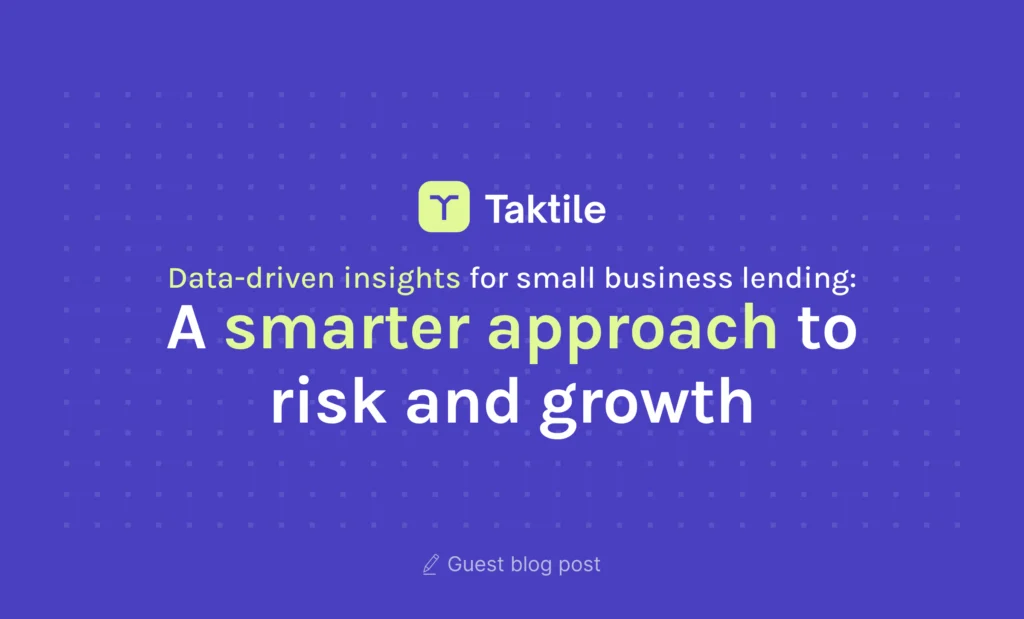This website uses cookies so that we can provide you with the best user experience possible. Cookie information is stored in your browser and performs functions such as recognising you when you return to our website and helping our team to understand which sections of the website you find most interesting and useful.
Data-driven insights for small business lending: A smarter approach to risk and growth

In small business lending, the need for accurate, fast decisions has never been greater. As businesses face growing demands and lenders seek to streamline their processes, the role of data-driven insights becomes crucial. Harnessing real-time information about borrowers can help lenders not only make more informed decisions but also respond quickly to the changing dynamics of the market.
While traditional lending practices relied heavily on manual processes and isolated data sets, modern lending has evolved. Today’s lenders must balance speed with risk, and this balance is most effectively achieved by seamlessly integrating third-party data and aggregation tools into their decision-making processes.
The complexity of small business lending
Small business lending presents unique challenges compared to traditional consumer or large business lending. Many small businesses lack extensive credit histories or standardized financial records, which makes assessing their creditworthiness more complex. Additionally, small business borrowers often approach multiple lenders and tend to accept the first offer they receive, adding pressure on lenders to respond quickly. Data-driven insights allow lenders to make more informed decisions by painting a complete picture of a borrower’s financial health, helping lenders strike the right balance between speed and risk.
Historically, there has been a trade-off between speed and accuracy: quick decisions often meant higher risk, while slower, more thorough assessments ensured greater accuracy. However, with access to rich, diverse data sources—such as transaction records, bank statements and tax documents—lenders are now able to form a holistic view of borrowers. This depth of information enables better decisions without the need to compromise between speed and accuracy, giving lenders a crucial advantage.
Enhancing risk assessment with real-time data
Risk assessment lies at the heart of lending, but traditional methods often fall short of providing the detailed, timely insights lenders need. By leveraging real-time data from diverse third-party providers and aggregators, lenders can gain a more nuanced understanding of a borrower’s financial behavior, cash flow patterns and risk profile. This allows them to better anticipate potential risks and make proactive decisions that are more aligned with the borrower’s current financial situation.
Real-time data enables lenders to detect trends and anomalies that might not be visible through static financial reports, improving their ability to assess creditworthiness accurately. However, underwriting should not be viewed as a one-time event.
With continuous access to updated information, lenders can re-evaluate creditworthiness on an ongoing basis, responding to a customer’s behavioral patterns or shifts in market conditions. This dynamic approach allows for timely adjustments to credit limits and risk models, ensuring that lending decisions remain aligned with real-time financial realities. By treating underwriting as a continuous process, lenders can not only mitigate risk more effectively but also enhance overall portfolio performance.
Expanding lending capabilities with seamless data integration
As lenders look to scale their operations and reach more borrowers, the ability to integrate multiple data sources seamlessly becomes critical. Relying solely on in-house capabilities to connect to third-party data can limit a lender’s capacity to make fully informed decisions and isolated systems can create bottlenecks in the underwriting process.
By utilizing technology providers that offer pre-built integrations with third-party data providers, lenders can access an expansive set of financial data without investing in complex, costly infrastructure changes.
As explained in Taktile’s Guide to leveraging third-party data in fintech decisions, seamless access to external data providers and aggregators not only enhances the scope of data available for decision-making but also streamlines workflows, reducing inefficiencies. Lenders can scale more effectively by leveraging real-time data sources that support better risk management, improving both approval rates and operational efficiency.
The future of small business lending: data as a strategic advantage
In the evolving landscape of small business lending, data is no longer just a tool—it’s a strategic asset. Access to diverse, accurate and real-time data equips lenders with the agility they need to thrive in a competitive market.
The ability to integrate and utilize rich data sources—whether from internal systems or trusted third-party providers—enables lenders to stay ahead of the curve. As market conditions shift and borrower expectations evolve, those who harness the full potential of data will be in the best position to scale their operations, improve approval rates and achieve sustainable growth.
Key takeaways:
- Holistic data insights help lenders assess small business risk more effectively, combining speed and accuracy.
- Real-time data enables lenders to detect trends and mitigate risks earlier in the lending process.
- Seamless data integration with third-party providers allows lenders to scale efficiently while enhancing decision-making capabilities.
- Data is a strategic asset that enables lenders to optimize risk assessments, improve decision-making and achieve sustainable growth in a competitive environment.






